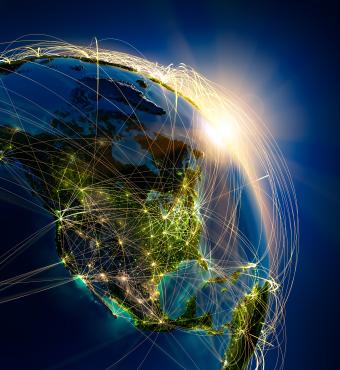- US Foreign Policy
- US Defense
- Security & Defense
- Determining America's Role in the World
America has returned to the Americas. Yet not everyone agrees with the White House’s new emphasis on the Western Hemisphere: there is mounting anxiety over “hemisphereism” as well as hyperbolic claims that American grand strategy is committing “superpower suicide.” In September, reports indicated that the Trump administration’s forthcoming national defense strategy (NDS) would fundamentally transform US defense policy, decisively elevating the homeland and Western Hemisphere security over the Indo-Pacific and deterring China. But even before the official release of the NDS, Beltway fears about an America in global retreat and a new foreign policy based on spheres of influence are legion.
Prioritizing the Western Hemisphere, however, does not mean sacrificing superpowerdom. Rather, waging a great-power competition against China requires the United States to focus on the Western Hemisphere. This is elementary foreign policy. Such hemispheric precedence would have sounded quite natural to earlier generations of Americans. The United States cannot deter adversaries and support allies without securing its hemisphere. Indeed, a monomaniacal policy of confronting China can look bizarre from the vantage of the Americas: what would be the purpose of countering China in other global theaters if the United States could not counter Beijing’s influence in its own neighborhood?
In personnel, policy, and posture, the Trump administration is executing a strategic pivot to the Western Hemisphere. The United States has undertaken maximum-pressure campaigns against authoritarian regimes, executed a consequential policy shift against transnational criminal organizations, squeezed China in various critical sectors, and pursued invigorated diplomacy to strengthen regional partnerships with like-minded countries.
Given the makeup of senior advisers and the president’s aims, no one should be surprised. Secretary of State (and acting national security adviser) Marco Rubio and Deputy Secretary of State Christopher Landau have deep regional expertise and an abiding personal interest in Latin America and the Caribbean. They happen to be the first fluent Spanish-speaking pair to run the State Department together. Secretary of War Pete Hegseth, the first head of the Pentagon to visit Panama in twenty years, favors the US Northern and Southern Command theaters. President Trump, for his part, instinctively orients toward the Western Hemisphere, where the core issues of his agenda manifest: China, migration, narcotics, and reciprocal trade.
The cardinal rule
Historically, the Monroe Doctrine has been a source of bipartisan consensus, and previous presidents prioritized building hemispheric security when the United States was involved in global conflicts.
President Franklin Delano Roosevelt executed his Good Neighbor Policy—abandoning intervention, reviving diplomacy, and rejuvenating US-Latin American relations—a prelude to his hemispheric defense doctrine in the run-up to the Second World War, an approach that safeguarded homeland and hemisphere from the encroachment of the Axis powers.
Amid the Cold War, President Kennedy launched the Alliance for Progress, an ambitious ten-year program meant to counter the threat from communist Cuba and offer a vision of economic progress based on market-based industrialization.
And during the Cold War’s twilight, the hemisphere was a central theater in President Reagan’s bid to emerge victorious over the Soviet Union. Reagan rolled back communism, advanced economic initiatives, and engaged in deft diplomacy. Central America was so important as a Cold War battleground that Jeane Kirkpatrick, Reagan’s tenacious ambassador to the United Nations, could avow to Newsweek in 1981: “Central America is the most important place in the world for the US today.”
Whether conducting a world war or Cold War, past presidents and their advisers grasped that although America possesses formidable power, effective power projection proves impossible without a largely safe, prosperous, democratic, and economically integrated Western Hemisphere.
Ironically and ahistorically, as US competition with China intensified, policymakers focused on other regions at the expense of the Western Hemisphere. In doing so, they forgot the cardinal rule of national security: “Foreign policy starts in your own neighborhood.” By pivoting strategically to the Americas, the Trump administration redresses a period of disregard, marking a return to hemispheric defense.
Hemispheric hotspots
The Trump administration’s actions in Panama, Venezuela, and Mexico are instructive, not the least because they signal strategic direction in key areas. There, the Trump administration has applied hard power and diplomacy in tandem to resolve challenges that bear directly on America’s capacity to confront the Chinese Communist Party (CCP).
Upholding the Panama Canal’s sovereignty and neutrality is one of the United States’ chief national security concerns. Beyond the economic rationale, the canal permits the timely transition of US naval forces from the Atlantic to Pacific theaters in the event of China acting against Taiwan or other Indo-Pacific allies and partners. Thus it made good strategic sense that Panama served as the opening salvo in Trump’s bid to secure the Americas. His administration pushed Panama’s President José Raúl Mulino to begin removing Beijing’s economic and political foothold in the isthmus, starting with CK Hutchison Holdings’ multidecade concessions to operate the Balboa and Cristóbal ports. Subsequently, the Panama Canal Authority signed a cybersecurity agreement with the US Southern Command, and the Mulino government both exited China’s Belt and Road Initiative and moved to replace Huawei equipment with American technology.
During his April visit to Panama, Hegseth issued a joint declaration on maintaining the neutrality of the canal and inked a memorandum of understanding that provided for rotational exercises at three bases, including jungle training. His April 9 remarks previewed the Trump administration’s hemispheric defense strategy, which defined irregular migration, transnational criminal organizations, and the CCP as paramount threats to the hemisphere. “To put America first,” Hegseth said, “we will put the Americas first,” echoing the mantra that Rubio announced in January and which the authors of this essay have long advocated.
Against Venezuela, the Trump administration has taken drastic measures to confront instability and the starkest example of a criminal regime in the Americas. Under the Nicolás Maduro regime, Venezuela became the origins of and the nexus for every major threat facing the hemisphere: allying with hostile extra-hemispheric powers, supporting transnational criminal organizations, weaponizing mass migration, and facilitating drug trafficking. Since August, the United States has deployed an array of military assets into the southern Caribbean to combat newly declared foreign terrorist organizations and pressure Maduro to vacate Caracas.
The Trump administration’s approach seeks to ensure that Maduro’s days are numbered as the region’s principal malign actor. The administration has designated drug cartels as foreign terrorist organizations, built up Caribbean naval and air assets to establish a cordon sanitaire around Maduro, and increased the bounty on Maduro to $50 million while dismissing his overtures.
Regime change would seemingly cut against Trump’s predilection for diplomatic resolution and negotiated deals, but the mistakes of previous administrations have demonstrated that Maduro’s combativeness has likely foreclosed the possibility of a peaceful retirement. Trump’s doctrine of “peace through strength” leaves only one option when diplomacy with such a regime fails.
Mexico
For both trade and national security, Mexico is arguably the most important country to the United States, and the Trump administration recognizes it. Mexico is the United States’ largest trading partner. Last year, the US-Mexico trade relationship amounted to $935 billion, a tremendous volume of goods and services that continues to grow within the framework of the US-Mexico-Canada Agreement. The future of US-Mexico security cooperation presents a trillion-dollar question.
Encouraged by the Trump administration’s use of economic leverage, Washington and Mexico City seek to collaboratively and forcefully address the grave problem of drug cartels. Rubio’s September visit with President Claudia Sheinbaum showed a deepening of mutual security efforts, harking back to the halcyon days of the George W. Bush and Felipe Calderón era, when the Mérida Initiative launched. Trump and Sheinbaum speak often, and high-ranking officials have established the US-Mexico Security Implementation Group to coordinate policy, including on thorny issues like arms trafficking. These actions contradict claims that the United States would intervene unilaterally in violation of Mexican sovereignty.
In fact, the Sheinbaum government invites close cooperation. The success of Sheinbaum’s economic agenda, Plan México, depends on eradicating cartels, attracting foreign direct investment, and forging a strong partnership with the United States against China. Mexico can be the drawbridge in a North American fortress against the CCP, using its potential economic might to choke off Chinese exports and pull investment away from China.
Mexico and the United States are also locked in a proxy war with China in their fight against drug cartels. As the House Select Committee on the CCP established, Chinese companies facilitate the cartels’ illicit enterprise, supplying precursor chemicals and manufacturing equipment to make fentanyl. Chinese money laundering organizations, meanwhile, have emerged as the premier intermediaries washing the profits.
Making the pivot permanent
Following the cardinal rule that foreign policy starts at home can bring many benefits. Their permanence, however, remains to be seen. To bring about a permanent shift in US defense and foreign policy priorities, the national defense strategy must guide decision-making rather than simply announcing attention to a long-neglected region:
- US Southern Command must receive more than its current budget of less than 1 percent of defense spending. SOUTHCOM’s meager budget is the source of many challenges faced by the combatant command, and it contributes to the $300 million yearly unfunded wish list. The NDS must spur the funding to match the theater’s priority.
- SOUTHCOM has no permanently assigned troops under its command, while its exercises and deployments tend to be quick and episodic. The NDS must provide enduring strategic direction.
- SOUTHCOM finds itself artificially split from countries in its natural area of responsibility sharing similar characteristics, challenges, and security concerns. For instance, the Bahamas and Mexico reside within the jurisdiction of the US Northern Command. Bureaucratic structures should not obstruct sound policy on the Western Hemisphere. The NDS must rethink assumptions about the demarcation between homeland and hemisphere—or at the very least offer guidance to ensure that the Bahamas and Mexico are not excluded from a coherent Western Hemisphere policy, owing to bureaucratic organization.
Without these basic changes, the Trump administration’s overdue pivot to the Western Hemisphere risks remaining rhetorical and limited, not operational and sustained. That would be a massive missed opportunity for both the United States and the people of Latin America and the Caribbean, who deserve to have an attentive and active neighbor to the north.

















